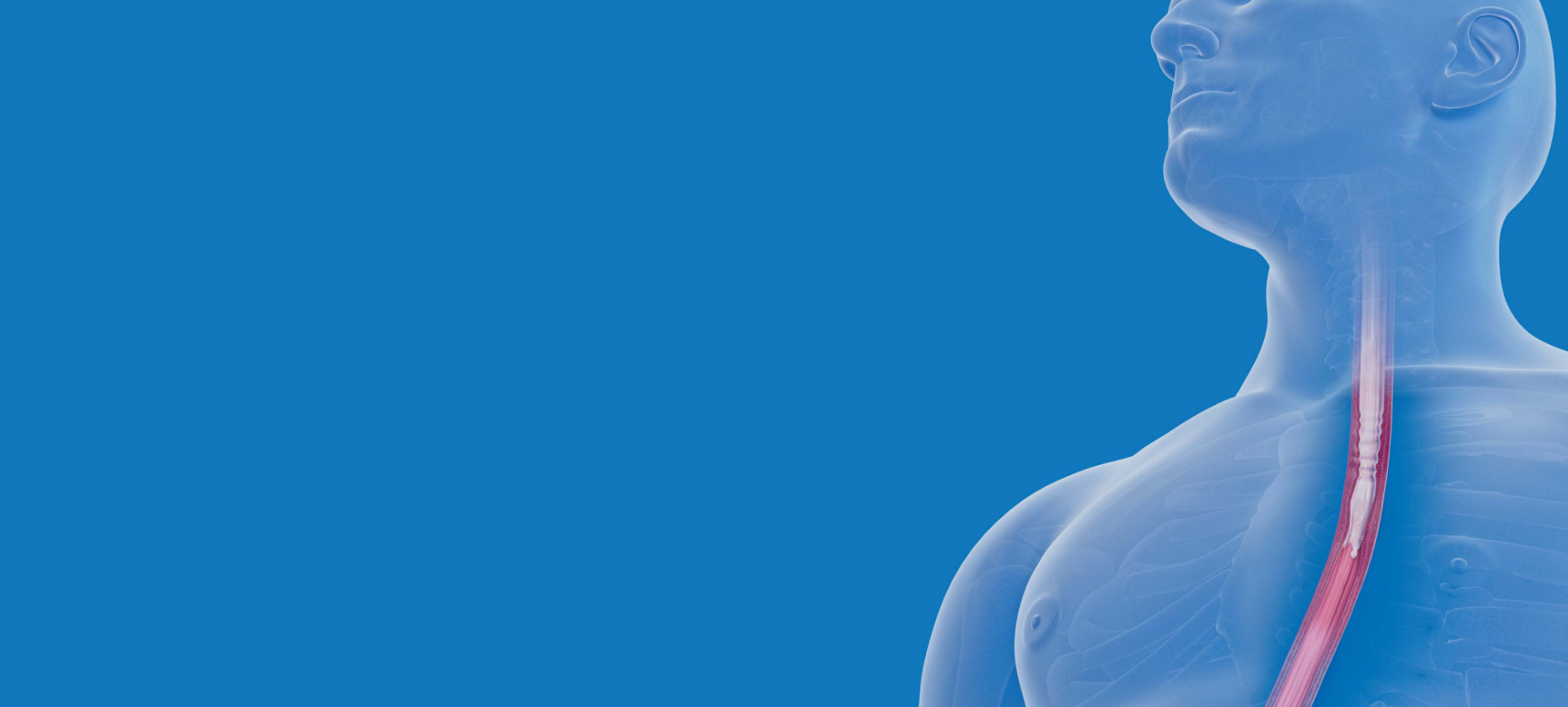Histological remission and dysphasia symptom response with EOHILIA were studied in two 12-week clinical studies that included 410 patients1
Study 1: Phase 3 study evaluated the efficacy and safety profile of EOHILIA vs placebo in 318 patients with EoE, 11 to 56 years old; treatment randomization: 2:1 for EOHILIA 2 mg b.i.d. or placebo.1,2
Study 2: Phase 2 study evaluated the efficacy and safety profile of EOHILIA vs placebo in 92 patients with EoE, 11 to 42 years old; treatment randomization: 1:1 for EOHILIA 2 mg b.i.d. or placebo.1,3
Efficacy Endpoints
- Histological remission: proportion of subjects achieving histological remission defined as a peak eosinophil count of ≤6 eos/hpf across all available esophageal levels1
- DSQ scores: absolute change from baseline in subject-reported DSQ combined score.1 The DSQ was a questionnaire developed and validated to specifically measure dysphagia associated with EoE4
Key Inclusion Criteria1-3,5
- Esophageal inflammation, defined as peak eosinophil
count ≥15 eos/hpf from at least 2 levels of the esophagus - ≥4 days of dysphagia over a 2-week period prior to
randomization, as measured by the DSQ - Non-responsiveness to 6 to 8 weeks of high-dose PPI
therapy
Key Exclusion Criteria1-3,5
- Use of swallowed topical corticosteroids for EoE or
systemic corticosteroids for any condition ≤4 weeks
before screening - Pure liquid or six-food elimination diet (SFED)*
- Use of CYP3A4 inhibitors
- Presence of a high-grade esophageal stricture
*In Study 1, subjects were excluded if they were on a full-liquid or six-food elimination diet. In Study 2, subjects were instructed to maintain a stable diet throughout the study.1
b.i.d.=twice daily; DSQ=Dysphagia Symptom Questionnaire; eos/hpf=eosinophils per high-power field; PPI=proton pump inhibitor.
References:
- EOHILIA (budesonide oral suspension) Prescribing Information. Takeda Pharmaceuticals, Inc.
- Hirano I, Collins MH, Katzka DA, et al. Clin Gastroenterol Hepatol. 2022;20(3):525-534.e10.
- Dellon ES, Katzka DA, Collins MH, et al. Gastroenterology. 2017;152(4):776-786.e5.
- Hudgens S, Evans C, Phillips E, et al. J Patient Rep Outcomes. 2017;1(1):3.
- ClinicalTrials.gov identifier NCT02605837. November 16, 2015. Updated June 8, 2021. Accessed September 6, 2024. https://classic.clinicaltrials.gov/ct2/show/NCT02605837.
- Data on file, Takeda Pharmaceuticals, Inc.
Studied in a wide range of patients with EoE1-3,6
Although there were some differences at baseline between Study 1 and Study 2, patient demographics and characteristics were generally similar.
| Study 1 (N=318) Phase 3 study | Study 2 (N=92) Phase 2 study | |
|---|---|---|
| Months since EoE diagnosis, mean (SD) | 45.9 (52.38) | 37.41 (38.36) |
| Mean age | 34 years (range: 11 to 56 years) | 22 years (range: 11 to 42 years) |
| Sex | 60% male (n=191), 40% female (n=127) | 68% male (n=63), 32% female (n=29) |
| Race + Ethnicity | White: 95% (n=301) | White: 95% (n=87) |
| Concomitant PPIs | >80% | >65% |
| Dysphagia symptoms at baseline, mean (SD) DSQ score | EOHILIA group*: 30.3 (13.9) 30.4 (13.1) | EOHILIA group: 30.7 (16.0) 29.0 (13.5) |
| Peak eosinophil count at baseline, mean (SD) | EOHILIA group: 74.5 (39.2) eos/hpf 76.6 (45.0) eos/hpf | EOHILIA group: 158.9 (96.7) eos/hpf 133 (81.6) eos/hpf |
| Previous esophageal dilation | EOHILIA group: 43% (n=91) 43% (n=45) | Not applicable |
| Mean (SD) total EREFS at baseline | EOHILIA group: 7.6 (3.6) 8.2 (3.3) | EOHILIA group: 7.8 (3.57) 7.0 (3.31) |
| Study 1 (N=318) Phase 3 study | |
|---|---|
| Months since EoE diagnosis, mean (SD) | 45.9 (52.38) |
| Mean age | 34 years (range: 11 to 56 years) |
| Sex | 60% male (n=191), 40% female (n=127) |
| Race + Ethnicity | White: 95% (n=301) |
| Concomitant PPIs | >80% |
| Dysphagia symptoms at baseline, mean (SD) DSQ score | EOHILIA group*: 30.3 (13.9) 30.4 (13.1) |
| Peak eosinophil count at baseline, mean (SD) | EOHILIA group: 74.5 (39.2) eos/hpf 76.6 (45.0) eos/hpf |
| Previous esophageal dilation | EOHILIA group: 43% (n=91) 43% (n=45) |
| Mean (SD) total EREFS at baseline | EOHILIA group: 7.6 (3.6) 8.2 (3.3) |
Study 1: EOHILIA, n=213; placebo, n=105. Study 2: EOHILIA, n=50; placebo, n=42.
*EOHILIA, n=211.
†Placebo, n=104.
Concomitant use of stable doses of inhaled or intranasal steroids (for conditions other than EoE), PPIs,
H2-receptor antagonists, antacids, antihistamines or anti-leukotrienes, and maintenance immunotherapy was allowed.1
Concomitant use of stable doses of inhaled or intranasal steroids (for conditions other than EoE), PPIs, H2-receptor antagonists, antacids, antihistamines or anti-leukotrienes, and maintenance immunotherapy was allowed.1
eos/hpf=eosinophils per high-power field; EREFS=endoscopic reference score; SD=standard deviation.
| Study 2 (N=92) Phase 2 study | |
|---|---|
| Months since EoE diagnosis, mean (SD) | 37.41 (38.36) |
| Mean age | 22 years (range: 11 to 42 years) |
| Sex | 68% male (n=63), 32% female (n=29) |
| Race + Ethnicity | White: 95% (n=87) |
| Concomitant PPIs | >65% |
| Dysphagia symptoms at baseline, mean (SD) DSQ score | EOHILIA group: 30.7 (16.0) 29.0 (13.5) |
| Peak eosinophil count at baseline, mean (SD) | EOHILIA group: 158.9 (96.7) eos/hpf 133 (81.6) eos/hpf |
| Previous esophageal dilation | Not applicable |
| Mean (SD) total EREFS at baseline | EOHILIA group: 7.8 (3.57) 7.0 (3.31) |
Study 1: EOHILIA, n=213; placebo, n=105. Study 2: EOHILIA, n=50; placebo, n=42.
*EOHILIA, n=211.
†Placebo, n=104.
Concomitant use of stable doses of inhaled or intranasal steroids (for conditions other than EoE), PPIs, H2-receptor antagonists, antacids, antihistamines or anti-leukotrienes, and maintenance immunotherapy was allowed.1
eos/hpf=eosinophils per high-power field; EREFS=endoscopic reference score; SD=standard deviation.
